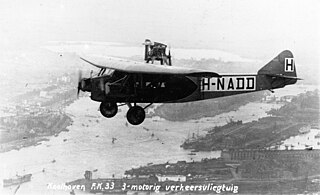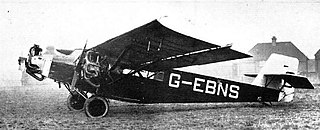Operators
- Australian Aerial Services
| Lascondor | |
|---|---|
| Role | monoplane airliner |
| Manufacturer | Larkin Aircraft Supply Company |
| Designer | W. S. Shackleton |
| First flight | 23 March 1930 |
| Introduction | 1930 |
| Retired | 1934 |
| Primary user | Australian Aerial Services |
| Number built | 1 |
The Lasco Lascondor (also frequently known by the misspelling "Lasconder") [1] was a 1930s Australian 8-seat passenger and mail carrier aircraft built by the Larkin Aircraft Supply Company (Lasco) at Coode Island, Victoria. It is claimed to be the first multi-engined aircraft designed and built in the Southern Hemisphere. [2]
Development of the Lascondor began in June 1928, concurrently with the company's Lascoter; [3] the two aircraft had 90% commonality of structural parts. [2] Like the Lascoter the Lascondor was a high-wing monoplane with a tubular steel structure, featuring a tailwheel undercarriage and a fully enclosed cabin for the passengers and the pilot. A major change was the Lascondor's three Armstrong Siddeley Mongoose engines instead of the Lascoter's single more powerful Siddeley Puma engine. The Lascondor also had greater fuel capacity and a slightly longer fuselage with a redesigned cabin to accommodate an extra row of seats. [2] In addition, while the Lascoter had two sets of flying controls in the cockpit the Lascondor had only one to allow for another passenger seat, giving an overall capacity of seven passengers and one pilot. [2]
Data from Meggs, p.219
General characteristics
Performance
Avionics
None

The Airspeed AS.8 Viceroy was a British racing version of the Airspeed AS.6 Envoy built by Airspeed (1934) Limited at Portsmouth. The Viceroy was built to order for Captain T. Neville Stack and Sydney Lewis Turner, to compete in the England-Australia MacRobertson Air Race. Only one aircraft, registered G-ACMU, was built.

The Canadian Vickers Vancouver was a Canadian transport/patrol flying boat of the 1930s built by Canadian Vickers.

The ANEC III was a 1920s British six-seat passenger and mail carrier aircraft built by Air Navigation and Engineering Company Limited at Addlestone, Surrey.

The Avro Club Cadet was a 1930s single-engined British biplane trainer aircraft, designed and built by Avro as a development of the earlier Cadet. It was planned for private and club use and, unlike the Cadet, was fitted with folding wings.

The Avro 627 Mailplane was a British biplane developed in 1931 by Avro from the Avro Antelope bomber as a mail plane for use in Canada. Only one was built which ended up being used as a test bed.

The Avro 641 Commodore was a British single-engine five-seat cabin biplane built by Avro in the mid-1930s for private use. A total of only six were built, including the prototype.

The Avro 547 was a prototype triplane airliner developed in Britain after the First World War. It utilised components from the highly successful 504 but added an extra set of wings and a new deep fuselage housing a fully enclosed cabin to seat four passengers. The aircraft was powered by a 160 hp (120 kW) Beardmore engine. The pilot sat in an open cockpit offset to port. The prototype flew well, having similar characteristics to a 504, the second example built was substantially modified, in order to compete in a British Air Ministry competition for a commercial aircraft, being fitted with a 240 hp (180 kW) Siddeley Puma engine. Designated 547A, this version turned out to be slow and unstable in the air and failed to win an award in the competition in August 1920. Damaged in a forced landing at the competition, the second prototype was scrapped in 1922.

The Caproni Ca.101 was a three-engine Italian airliner which later saw military use as a transport and bomber. It was designed in 1927 and first flown in 1928.

The Koolhoven F.K.51 was a 1930s Dutch two-seat basic training biplane built by the Koolhoven Company.

The Edgar Percival E.P.9 was a 1950s British light utility aircraft designed by Edgar Percival and initially built by his company, Edgar Percival Aircraft Limited and later as the Lancashire Aircraft EP-9 Prospector by the Lancashire Aircraft Company.

The FMA AeC.1 was a light utility aircraft built in Argentina in 1931; it was the first aircraft of domestic design to be produced by Fabrica Militar de Aviones (FMA). It was a low-wing cantilever monoplane of conventional configuration with fixed tailskid undercarriage. As originally designed, the fully enclosed cabin had three seats, but this was later reduced to two. The passenger seat could be readily removed to make way for a stretcher to facilitate its use as an air ambulance.
The FMA AeC.3 was a light utility aircraft built in Argentina in 1934; a further development in the series of designs that had originated with the AeC.1 three years previously. Deliveries to Argentina's aeroclubs were made late in the year.
The Lublin R-XII was the Polish three-seat sports and touring aircraft, designed in 1930 in the Plage i Laśkiewicz factory in Lublin, that remained a prototype.

The NVI F.K.33 was an airliner built in the Netherlands in 1925 for use by KLM for night flying.
The Lasco Lascoter was a 1920s Australian 6-seat passenger and mail carrier aircraft built by the Larkin Aircraft Supply Company (Lasco) at Coode Island, Victoria. It was the first Australian-designed and built airliner to be granted a Certificate of Airworthiness.

The Sablatnig P.III was an airliner produced in Germany in the early 1920s.

The Handley Page HP.32 Hamlet was a British six-passenger monoplane transport designed and built by Handley Page. Only one was built to order of the Air Ministry, first flown with three-engines, later changed to two then back to three engines.
The Sopwith Antelope was a British three-seat transport aircraft built after the end of the First World War. A single-engined biplane based on the Sopwith Wallaby long-range aircraft, only a single Antelope was built.

The Civilian Coupé is a British, single-engined two-seat private monoplane built starting in 1929. Only five were made and it was the Civilian Aircraft Company's only product, but one still flies in the UK.

The Comte AC-12 Moskito was a 1930s Swiss three-seat light touring cabin monoplane produced by Flugzeugbau A. Comte.